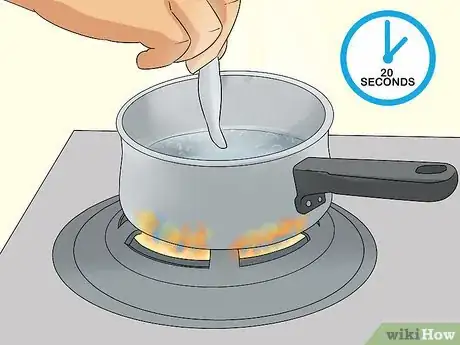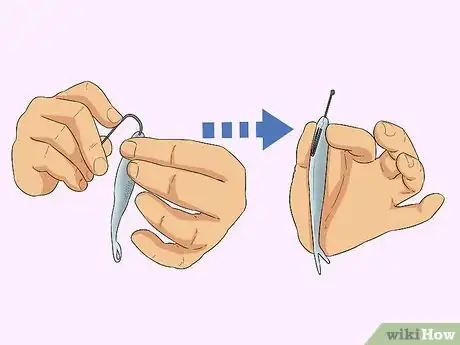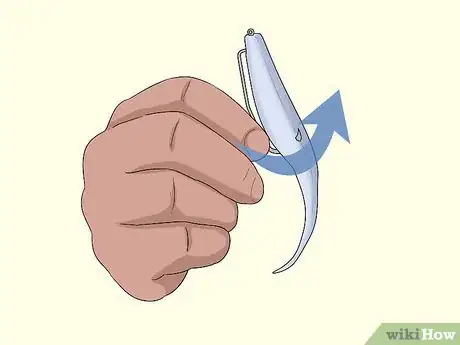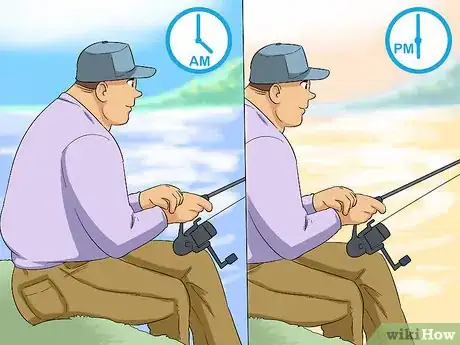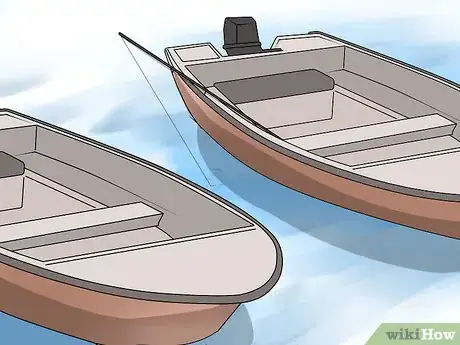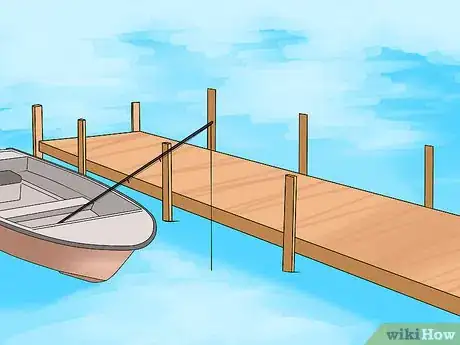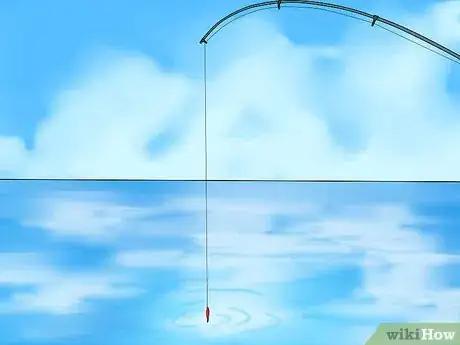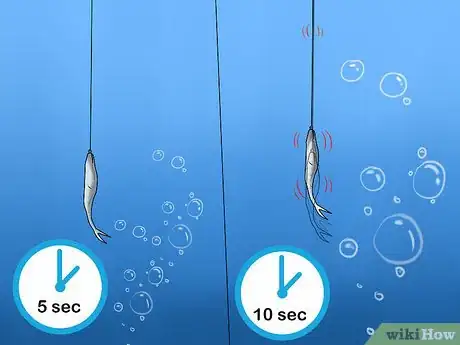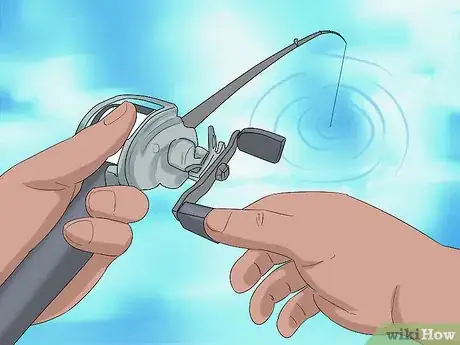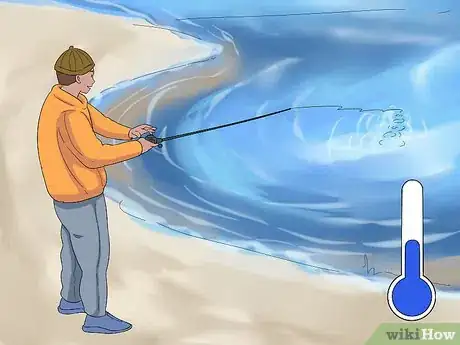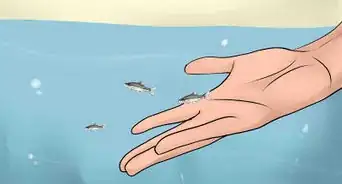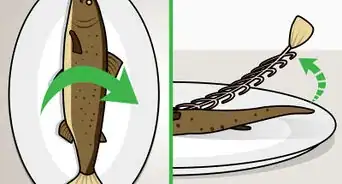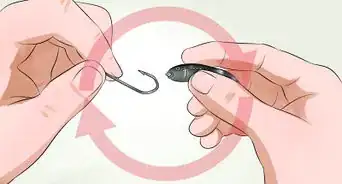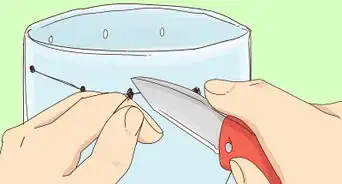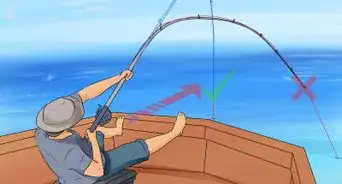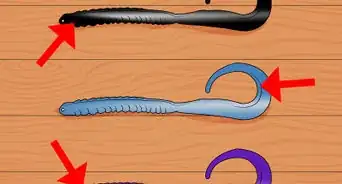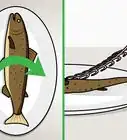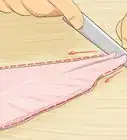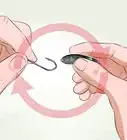This article was co-authored by wikiHow Staff. Our trained team of editors and researchers validate articles for accuracy and comprehensiveness. wikiHow's Content Management Team carefully monitors the work from our editorial staff to ensure that each article is backed by trusted research and meets our high quality standards.
This article has been viewed 20,773 times.
Learn more...
Fluke is a federally registered trademark of Zoom Bait Co. for a type of soft, plastic bait used to catch a variety of types of fish, including bass. Fluke brand baits are a versatile type of bait, roughly shaped like a shad. Fluke brand baits can be fished in a variety of ways, making them a good type of bait for beginners, as well as a useful bait to put on your line when the fishing is difficult.
Steps
Shaping and Hooking the Fluke
-
1Dip the fluke in boiling water for 20 seconds to straighten the plastic. When flukes are packaged and shipped, their natural shape often becomes distorted. To return the flukes to their natural shape, hold them in boiling water until they begin to straighten out.[1] You can do this in a small saucepan. To ensure that you can dip the entire fluke, fill the pan with at least 5 inches (13 cm) of water. If the fluke is still slightly curved after a 20-second soak, hold it flat on a towel until it dries straight.
- Since flukes are most often fished weightless (with no added weight), it's important that their shape not be distorted. A distorted fluke won't fish well, and will not catch many bass.
-
2Hook the fluke directly down the center of the bait. Hold the fluke vertically in your hand, and insert the point of the hook into the “head” of the fluke. Press the point of the hook down through the body of the fluke for roughly 1⁄4 inch (0.64 cm), and angle the hook so that it re-emerges from the underbelly of the fluke. [2]
- Average sized flukes range between 4–5 inches (10–13 cm), but you can also use tiny flukes as small as 2 inches (5.1 cm) or magnum flukes as large as 7 inches (18 cm).
Advertisement -
3Press the hook through the body of the fluke. Keep pushing the length of the hook through the bait until only about 1⁄2 inch (1.3 cm) is left sticking out the top of the fluke.[3] Make sure that the eye of the hook is still visible.
- Flukes work best when hooked on a round-bend hook. Use a strong hook, so heavy fish won't straighten the hook out with their weight.
-
4Fish the fluke using a braided fishing line. Braided lines are ideal for casting flukes: the line is strong enough to catch a large bass, and won't stretch under the fish's weight.[4] You can find braided fishing line of various weights at a local outdoors supply store.
- If you're fishing for bass, use a 50- or 65-pound braided line.[5]
-
5Tie the fishing line through the eye of the hook. Once the hook is in position, slip about 3 inches (7.6 cm) of the tip of the braided fishing line through the eye at the base of the hook. Secure the hook to the line by wrapping the line back around itself 6 times. Be sure to leave a small opening next to the top of the eye. Then, pass the tip of the line back through the opening at base of the 6 wraps. Finally, use your fingers to tighten the knot.
- While you're tying the line, be careful not to catch your skin on the point of the hook.
Selecting a Spot to Fish
-
1Fish in the early morning or late afternoon. Fish bite most often during these times, and are also most likely to be found in shallow grass beds. If you're fishing in the mid-day, you're unlikely to find fish around shallow grass beds. Fish retreat to deeper, cooler water during the heat of the day.[6]
- Take note of the weather, also. If it's calm out, the fish may be in shallow grass right next to the river or lake bank. If it's windy, however, the fish will go deeper and farther out from the shoreline.
-
2Find a shallow grass bed to fish the fluke. When scouting a fishing location, trawl around the edges of the lake until you find a thick, large patch of underwater grass. Grass beds slow down fishes' movements and provide fish with a feeding location, making them an excellent location to cast your fluke.[7]
- If you're lucky, the underwater grass may entangle the fish once you've caught one, making it more difficult for the fish to swim away and escape capture.
-
3Sink your fluke in between other fishing boats. Bass and other fish often congregate in shadowy areas, including between large, static fishing boats. Look around the lake you're fishing in, and scout out a good location. The boats should be anchored near the shore, and should be at least 12–15 feet (3.7–4.6 m) apart from one another. If they're much closer, you may end up casting your line onto one of the boats.[8]
- Remember to be polite when casting between boats. Alert other fishers when you're casting your line near their boats.
-
4Choose a location on the side of a dock or fishing pier. Bass and other fish may gather in the shade beneath the dock to hunt, or they may be resting deeper, near the base of the large beams which hold the dock in place. Try both locations: first cast your fluke into the shallow water beneath the dock and closer to the short, then, if the fish aren't biting, re-cast the fluke into deeper water near the dock's support beams.[9]
- If other fishers are also casting into these waters, don't cast within about 20 feet (6.1 m) of their lines. This is seen as polite fishing etiquette.
Casting the Fluke
-
1Cast the fluke into the patch of water you'd like to fish. Before you cast the rod, let out about 1 foot (30 cm) of line—with the fluke at the end—to give some weight to the line you'll cast. Hold the rod out to one side of your body. Whip the rod forward, and release the line once the rod is directly in front of you. The line will shoot out of the tip of the rod and, if you've aimed well, the fluke should land in the area of water you'd like to fish.
- If you're new to fishing, it may take several tries before you feel comfortable casting the line.
-
2Jerk the fluke across the water to attract fish to the bait. Cast the fluke out to the area in which you'd like to fish, and let it rest in the water for about 5 seconds. Then, jerk on the line twice in succession. Let the fluke rest on the surface for another 10 seconds.[10] Repeat the “jerk, jerk, pause” motions until you've reeled the fluke bait back to your boat or fishing post.
- This maneuver also known as the “jerk, jerk, pause” method of fluke fishing, and mimics the motions of a small dying fish. Erratic motions—like jerking and skipping—will arouse the fish's curiosity and induce them to bite the bait.
-
3Reel the fluke across the surface of the water to cover a lot of space. This is also called “burning” the fluke. Cast the fluke far out into the water you're fishing in, and reel it back into the boat (or fishing post) as quickly as possible. The fast reeling will keep the fluke on the surface of the water, and create enough of a disturbance to draw the attention of many nearby bass.[11]
- The “burning” technique will work best if you're using a high gear ratio reel, like a 7.1:1.
-
4Skip the fluke across the water to attract more fishes' attention. Cast the fluke far out from where you're fishing, and begin reeling it in quickly as if you were burning the fluke. As you're reeling, every 5 seconds or so, give the rod a sharp jerk to one side or another. The fluke will skip from side to side, and [12]
- To make the fluke skip along the surface of the water, give the rod several twitches in a row.
- Generally speaking, jerkbaits (like the fluke) work best when they're pulled through the water with an erratic motion.
-
5Slow down the jerks and skips in cold weather. Once summer turns to fall and winter, bass and other fish will become more lethargic and slower. However, the fluke is still an excellent bait to use in cold weather. The trick when fishing in the cold is to move the fluke more slowly so that the lethargic fish will be able to catch it.[13]
- So, use the same types of erratic casting (jerking and skipping) as you would during summer weather. But, lengthen the pauses. Instead of pausing for 10 seconds between jerks, let the fluke pause for 15-20 seconds.
Things You'll Need
- Fluke(s)
- Small saucepan
- Towel
- Round-bend hook
- 50- or 65-pound braided line
- 7.1:1 reel
- Fishing rod
References
- ↑ https://www.youtube.com/watch?v=f230f6zDyEY&feature=youtu.be&t=55s
- ↑ https://www.youtube.com/watch?v=SiIYDid-ZPs&feature=youtu.be&t=51s
- ↑ https://youtu.be/SiIYDid-ZPs?t=1m52s
- ↑ https://www.bassfishermansguide.com/how-to-fish-a-fluke/
- ↑ https://www.bassmaster.com/how-to/news/what-line-should-i-use/
- ↑ http://www.fallforfishing.com/how-to-fish-a-fluke/
- ↑ http://www.fallforfishing.com/how-to-fish-a-fluke/
- ↑ http://www.fallforfishing.com/how-to-fish-a-fluke/
- ↑ http://www.fallforfishing.com/how-to-fish-a-fluke/
